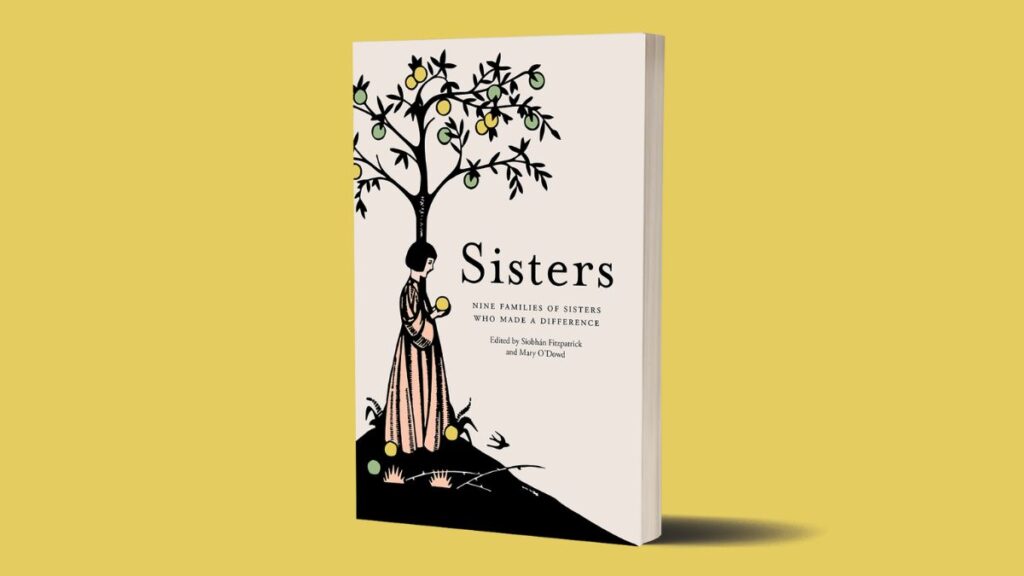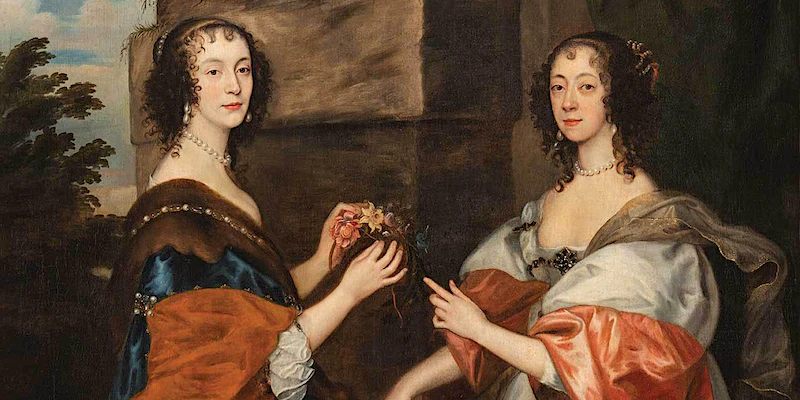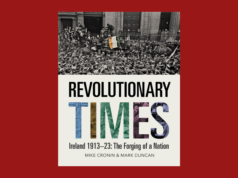
An extract from Sisters, edited by Siobhán Fitzpatrick and Mary O’Dowd (Royal Irish Academy)
Sisters traces the public and private lives of nine sets of sisters. Artists, publishers, writers, educationalists, philanthropists, revolutionaries, suffragists — women who overcame barriers, even within their own families, to their participation in public life.
Their stories have often been overlooked by the mainstream historical record.
The essays in Sisters take readers on a journey through the centuries—from the 1600s to the turbulent years of the independence struggle in 1900s Ireland—and uncover the influence, support and rivalries of family.
This extract concerns the seventeenth-century Boyle sisters and their letters.
by Dr Ann-Maria Walsh
The custom of fostering out children was a practice commonly associated with early modern aristocratic households, and sisters Alice, Mary and Margaret spent part of their childhoods with Sir Randall and Lady Anne Clayton, who were also neighbours and close associates of the Boyles.11
Mary, who later became the countess of Warwick, acknowledged in her autobiography that, while her mother had died when she was very young, Lady Clayton had ensured that she was ‘soberly educated’. 12
Apart from being provided with a religiously themed education, noble daughters in Anglo-Irish families like that of the Boyles were also instructed how to compose and write letters, to speak and write in the French language, to occupy themselves with needlework, to engage in polite conversation and, most importantly, how to manage multiple residences and landed estates.13
The family records confirm that professional tutors were a constant presence in the Boyle household, and it is therefore plausible that the three Boyle girls who remained in the natal home, Sara, Lettice and Joan, might have inadvertently benefited from the kind of ‘text- based learning’ that was taking place within that same domestic space.14

See all lectures in the series here
Sibling closeness
While noble sons and daughters may have been educated apart and with different objectives in mind, what is sometimes ignored or forgotten is the ‘relationship between those separately educated sons and daughters’.15 In the case of siblings Sara and Richard, three letters illustrate how they availed of that medium to maintain their close affinity, irrespective of their actual geographic distance.16
The colourful content and the shortened intervals between those particular letters reflect Richard’s determination to include Sara, albeit remotely, in his educational grand tour of Europe.
More generally, the letters underscore how the practice of family writing might have helped to transform childhood friendships into fruitful adult relationships.
Diary notes and correspondence exchanged between three of the other Boyle siblings, Katherine, Mary and Robert, highlight how they seemingly encouraged and stimulated each other’s overlapping interests in religion, medicine, science and writing.17

Strategic matches
Patrick Little notes how Richard Boyle started planning his daughters’ futures as early as their infanthood, by studying genealogies and employing antiquarians to research the pedigree of families with potential suitors.18
Five out of the seven daughters were strategically matched with Irish-based nobles, while the third and seventh daughters, Lettice and Mary, married the sons of influential English lords.
All of those marital manoeuvres increased the Boyles’ landed presence across the territories of Britain and Ireland, as well as broadening the family’s network of noble alliances and important political contacts.
Unhappiness
For the Boyle daughters, most of their marriages resulted in misery and unhappiness, but the archival evidence also reveals the different ways in which the women came to rely on their pens to adjust and to cope with adversity.
A letter from Sara, dated late October 1623, illustrates how she adapted to the changed reality of her life.19 Two years earlier Sara had been married to Sir Thomas Moore, heir to Garrett Moore, 1st viscount Drogheda, but in the intervening period Sara remained with the natal family until Sir Thomas returned from his European grand tour and was ready to escort his new wife the two hundred miles north to their marital home.
When Sara wrote to her father reassuring him of her safe arrival at Mellifont Abbey, County Louth, she used the opportunity to signal her continuing filial duty through the carefully ornate italic script and deferential tone.
Responsibilities
Sara also included in the letter a request to retain her father’s ‘gildinge [gelding]’ that had carried her with great ‘ease’ to Mellifont, so that she could work towards becoming a ‘beter horsewoman’. The reference to the horse that Sara had grown familiar with over the course of the journey from Lismore suggests that she was conscious of the need to put on record her intention to self-improve, and to take on the responsibilities associated with her new role as a landed noblewoman.
The letter thus perceptibly marks in an official sense that pivotal moment of change in a woman’s life, when she transitioned from child and dependent on her father to adult married woman. The consequences of the move to Mellifont also meant that the link between Sara and her siblings would necessarily become stretched.
The importance of the letter is thus reinforced as a physical point of contact with the natal family, and as a mechanism to track the writer’s progress while she adjusted to both her alien surroundings and to her new identity as Lady Sara Moore.
You can order a copy of Sisters here.
Endnotes
11 Dorothea Townshend, The life and letters of the great Earl of Cork (London, 1904), 58. 12 Mary Rich, Autobiography of Mary Boyle, Countess of Warwick(London, 1848), 2. 13 See example of child’s letter in, TDC, C, CM/24.107, Katherine Jones to Richard Boyle, 1st earl of Cork [?1638–41].
14 A.B. Grosart (ed.), The Lismore Papers, 1, ii, (5 vols; London, 1886), 249. On 16 May 1629 the earl of Cork records that ‘Mr ffrye’ had come to Lismore to be hisson Richard’s tutor. On the subject of women’s literary skills within families see, Rebecca Krug, Reading families: women’s literate practice in late medievalEngland (Ithaca and London, 2008), 12–13.
15 Naomi J. Miller and Naomi Yavneh, ‘Introduction: Thicker than water: evaluating sibling relations in the early modern period’, in Miller and Yavneh (eds),Sibling rela- tions and gender in the early modern world: sisters, brothers and others (Aldershot, 2006), 1–14: 2.
16 TDC, C, CM/17.146,151,154, Three letters from Richard Boyle, Viscount Dun- garvan to his sister, Lady Sara Digby, 8 June, 6 July, 30 July 1633.
17 Mary Rich, Memoir of Lady Warwick (London, 1847), 243. Rich references numer- ous occasions when she enjoyed meeting with her siblings.
18 Patrick Little, ‘The Geraldine ambitions of the first earl of Cork’, Irish Historical Studies 33(130) (November 2002), 151–68.
19 TDC, C, CM/14.189, Lady Sara Moore to Richard Boyle, 1st earl of Cork, endorsed 1 November 1623. Sara’s marriage to Sir Thomas Moore was short-lived; he died of smallpox a month after their arrival at Mellifont. Three years later Sara married Sir Robert Digby.











